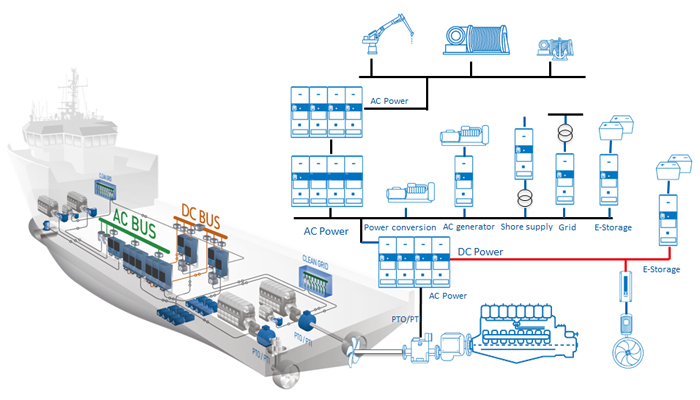
Ships require power for propulsion when operating at sea and when docking in the harbor, and also to operate equipment on board at all times. 98% of vessels are still diesel-powered. However, due to stricter global regulations related to NOx emissions, alternative fuels and other technology solutions must be found.
The marine and offshore industry is looking for ways to reduce consumption of diesel oil and minimize emissions. A move towards using cleaner fuels like liquefied natural gas (LNG) is already in place. The future will be a move towards the operation of fully electric vessels. In the meantime, shipyard and vessel owners are investing more and more in marine hybrid systems to increase flexibility in design and installation, optimize operational performance and minimize environmental impact. Currently, all vessel types from small shuttles to huge flight carriers can utilize hybridization technology for a more efficient and cleaner performance.
The benefits are clear business drivers:
improved vessel performance
reduced emissions
lower operating costs due to lower fuel consumption
lower maintenance costs related to diesel engines
reduced noise levels
improved long-term efficiency of the power supply system
Hybridization utilizes AC drives in the form of power conversion and grid converter technology. VLT® and VACON® AC drives are in place when hybridized energy production is used with generators, and hybridized loads is used, for example, with propulsion and cranes.
Hybrid vessels run using two or more power sources: Main engines and generators are usually combined with integrated energy storage in the form of batteries or super capacitors. The intention is first to hybridize either the energy production to ease up the main engine optimization and secondly to hybridize all machinery consuming the energy to optimize machine behavior.
The marine and offshore industry recognizes the potential of using hybrid power and innovative propulsion systems. They reduce emissions and improve fuel consumption while extending engine maintenance intervals and engine life. With hybrid solutions, it is even possible to reduce the size of the engine saving investment costs and space on board.
In energy production, the flexibility comes in the form of ‘time’. Energy storage gives time for generation to react to changes in loading conditions in an optimal way. On the load side, loading behavior is not reliant on generation and is ‘time’ constant.
Proven feedback and design targets from operating hybrid vessels has shown that using multi-source energy solutions to power vessels can reduce fuel consumption by 20–30%. You can choose to stop a diesel engine and run on battery or a smaller generator, or disconnect the battery or generator and start the engine again.
In the case of special vessels like tugs and support vessels, for example, they spend a lot of their service time idling with the main engines running and ready to respond, but no power is actually being used for propulsion. With hybrid solutions, batteries and smaller diesel generators can be used to provide energy to the vessel when it is idling, in standby operation, while harbor maneuvering or transiting short distances. A similar process can be used with regard to ferries operating in start/stops and scheduled routes. With regard to dynamic positioning, batteries can be used to provide the power for propulsion until the additional main engine is started and accelerated to provide long-term power for propulsion.
Generally speaking, the design of vessels with modern electric propulsion systems, either diesel electric, LNG electric or even fully electric, can be quite easily converted to a hybrid solution. In the best case, just by adding a parallel E-Storage system, a vessel can be operated utilizing battery power for example for peak power demand. In some cases, the optimum solution is to use DC power distribution instead of, or in conjunction with, traditional AC power distribution.
Many long-haul vessels are still operating with direct diesel propulsion and no electric propulsion system at all. These vessels can improve efficiency and optimize main engine load power and emissions by adding a shaft generator/motor between the propeller and the main engine. This solution, called Power Take Out and Power Take In, is an electrical add-on which makes these vessels more efficient and even ready for hybridization. In hybrid vessels, a shaft generator/motor with AC-drive technology allows the optimum control of propulsion machinery at various speeds which saves energy.
When using drive technology in a shore-supply solution, ships can source clean energy from local grids. The ship’s main generators can be switched off completely to prevent unnecessary NOx and carbon emissions and noise pollution while the vessel is docked.
Danfoss Drives provides VLT and VACON AC drives and Inverters and low harmonics solutions in the form of 12 pulse drive and active filters. Our power conversion offering is based on Active Front End AFE technology and DC-DC converters in case a DC power adaptation system is needed. Grid converters use Active Front End AFE technology with proper software able to create and control AC-grid (Micro Grid) behavior.
The E-storage/battery/super capacitor interface to an AC-grid or a DC-grid can use Grid converter technology or a DC-DC converter depending on grid voltage and battery DC-voltage behavior and demand for DC-voltage adaptation.